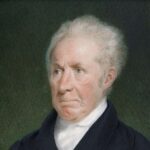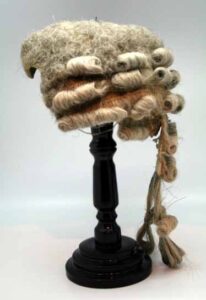
 Every era has its trends. And the affluent sector of society is far more likely to go for the odd trends, to prove that they are high society, than the everyday guy. One such trend, that took place in the second half of the 18th century, was the wearing of the wig. It was considered a major status symbol. Nevertheless, by 1800, short, natural hair was all the rage again. That seems to be the problem with trends. Sometimes, they barely get started and suddenly they are over. The trend was toward the wearing of curly white wigs by gentlemen in the 18th century as part of their everyday look. Of course, many people will remember George Washington, with a nod of their head, but the reality is that George Washington never wore a wig. That was his real hair, with the addition of white powder. He, unlike many other men of that era, had a head full of red hair. He powdered it, because will he had plenty of hair to look like a wig, it was red. When Gilbert Stuart, the famous portraitist, painted the Founding Fathers, he depicted five of the first six Presidents with pure white hair. Unlike Washington, the next four Presidents, John Adams, Thomas Jefferson, James Madison and James Monroe did wear wigs, so his depiction of them was correct, and Washington wore his hair in that style, so he could look like he wore a wig without the expense of one.
Every era has its trends. And the affluent sector of society is far more likely to go for the odd trends, to prove that they are high society, than the everyday guy. One such trend, that took place in the second half of the 18th century, was the wearing of the wig. It was considered a major status symbol. Nevertheless, by 1800, short, natural hair was all the rage again. That seems to be the problem with trends. Sometimes, they barely get started and suddenly they are over. The trend was toward the wearing of curly white wigs by gentlemen in the 18th century as part of their everyday look. Of course, many people will remember George Washington, with a nod of their head, but the reality is that George Washington never wore a wig. That was his real hair, with the addition of white powder. He, unlike many other men of that era, had a head full of red hair. He powdered it, because will he had plenty of hair to look like a wig, it was red. When Gilbert Stuart, the famous portraitist, painted the Founding Fathers, he depicted five of the first six Presidents with pure white hair. Unlike Washington, the next four Presidents, John Adams, Thomas Jefferson, James Madison and James Monroe did wear wigs, so his depiction of them was correct, and Washington wore his hair in that style, so he could look like he wore a wig without the expense of one.
Trends weren’t the only reason for the wigs, however. In the 17th century, hairlines were an important aspect of fashion. It was thought that a “well-bred man” would have a good hairline. Unfortunately, in the pre- antibiotics world, syphilis was on the rise in Europe. It ultimately affected more Europeans than the Black Plague. Without antibiotics, people afflicted with syphilis suffered all the effects, including sores and patchy hair loss. That became a huge problem for men of status. Because of that, wigs were commonly used to cover up hair loss, and it wasn’t until two Kings started to lose their hair, that their use became widespread. King Louis XIV of France experienced hair loss at the early age of 17, and he hired 48 wigmakers to help combat his thinning locks. His English cousin, King Charles II, began wearing wigs a few years later, when his hair began to grey prematurely. Both conditions were indications of syphilis. A fashion was born, as courtiers started wearing wigs, and the trend trickled down to the merchant class. Of course, as we all know syphilis was not the only reason for balding, nevertheless, it could have been a bad thing to have people assuming.
antibiotics world, syphilis was on the rise in Europe. It ultimately affected more Europeans than the Black Plague. Without antibiotics, people afflicted with syphilis suffered all the effects, including sores and patchy hair loss. That became a huge problem for men of status. Because of that, wigs were commonly used to cover up hair loss, and it wasn’t until two Kings started to lose their hair, that their use became widespread. King Louis XIV of France experienced hair loss at the early age of 17, and he hired 48 wigmakers to help combat his thinning locks. His English cousin, King Charles II, began wearing wigs a few years later, when his hair began to grey prematurely. Both conditions were indications of syphilis. A fashion was born, as courtiers started wearing wigs, and the trend trickled down to the merchant class. Of course, as we all know syphilis was not the only reason for balding, nevertheless, it could have been a bad thing to have people assuming.
The wigs were called perukes. They were convenient because they were relatively easy to maintain, only needing to be sent to a wigmaker for a delousing. I’m sure that the powder, often flour, attracted every kind of bug imaginable. As wigs became more popular, they became a status symbol for people to “flaunt their wealth. An everyday wig cost 25 shillings, a week’s worth of wages for a common Londoner. The term ‘bigwig’ stems from this era, when British nobility would spend upwards of 800 shillings on wigs. In 1700, 800 shillings was approximately £40 (about $50 today) which when calculated for inflation, comes out to around £8,297 or $10,193 in today’s currency.”
Men weren’t the only ones to buy into the trend. Women, like Marie Antoinette were famous for their wigs. Military officers, especially in the British Army, also wore wigs. Some officers wore wigs, but only very specific military plait wigs, not the wigs that were bought and worn by those in high society. According to Revolutionary War Journal, “perukes were hot and heavy, extremely expensive, and constantly infected with bugs,” which was 
 problematic for military use. In 1706, the military officers mostly used Campaign wigs, particularly the Ramillies wig, which was named after a British victory during the War of Spanish Succession. It was a short pigtail, or “queue” tied near the scalp and at the bottom of the plait. While these queues were originally fashioned from a soldier’s real hair, fake queues quickly became the norm. Nevertheless, the wigs were hot and uncomfortable, they were often bug infested, and by 1800, people were over it. That part hasn’t changed much over the years either. As anyone who wore a wig after Chemotherapy can tell you, at some point, most people just embrace the bald, and some men even shave their heads at the first sign of balding. Another was of embracing the bald.
problematic for military use. In 1706, the military officers mostly used Campaign wigs, particularly the Ramillies wig, which was named after a British victory during the War of Spanish Succession. It was a short pigtail, or “queue” tied near the scalp and at the bottom of the plait. While these queues were originally fashioned from a soldier’s real hair, fake queues quickly became the norm. Nevertheless, the wigs were hot and uncomfortable, they were often bug infested, and by 1800, people were over it. That part hasn’t changed much over the years either. As anyone who wore a wig after Chemotherapy can tell you, at some point, most people just embrace the bald, and some men even shave their heads at the first sign of balding. Another was of embracing the bald.


Leave a Reply